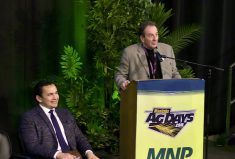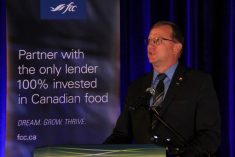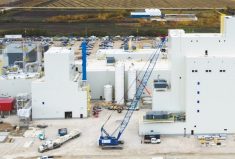Farmers are accustomed to seeing commodity prices rise and fall, while operating costs rarely go anywhere but up.
However, Manitoba farmers learned last week the cost of insuring their 2015 crops under AgriInsurance will drop by an average of 11 per cent — all because the effects of the 1988 drought have faded from memory and the long-term calculations used to determine insurance rates.
“As a result of removing the 1988 losses from the 25-year calculation… rates are down by an average of about 11 per cent in 2015,” Ron Kostyshyn, Manitoba’s minister of Agriculture, Food and Rural Development, told farmers attending Ag Days.
Read Also

Journal pulls long-cited glyphosate study for ethics violations
The journal Regulatory Toxicology and Pharmacology has retracted a 2000 Monsanto-linked glyphosate review, drawing new scrutiny as Bayer faces mounting legal pressure.
“That year, 1988, was a really terrible year,” added Craig Thomson, vice-president of insurance operations at the Manitoba Agricultural Services Corporation, which administers the program in Manitoba.
Speaking to producers at the Brandon Keystone Centre during Ag Days, the minister also noted that with the inclusion of the whopper 2013 harvest, probable 10-year averages have increased, meaning that participating producers will, on average, be paying lower premiums for higher coverage this year.
Other changes have also been announced for the long-standing program.
“Every year, Manitoba’s insurance and risk management programs are adjusted based on feedback from producers and other stakeholders,” Kostyshyn said. “These changes help provide a strong risk management framework for crop and livestock producers, young farmers and those affected by flooding and other challenges.”
Those changes include offering higher coverage for pedigreed soybeans in an effort to reflect the additional cost of producing pedigreed seed.
The escalating deductible for coarse hay has also been changed to a flat rate of 20 per cent under the harvest flood option — one of the new features introduced to forage producers last year.
The grade for which sunflowers — oilseed — can be guaranteed has also been increased to No. 1. The minister said this move was taken to reflect the average grade of Manitoba’s sunflower oil, which has improved.
Kostyshyn noted that 8,600 Manitoba farms have enrolled in AgriInsurance this year, representing more than 90 per cent of all annual crops in the province and putting total insured coverage at more than $2.3 billion.
“AgriInsurance is the first line of response for producers dealing with weather-related damages to their crops,” said Agriculture Minister Gerry Ritz, who was also on hand for the announcement. “We continue to work closely with Manitoba to ensure producers have access to predictable and bankable programming designed to meet their needs.”
For most AgriInsurance programs, premiums are shared 40 per cent by participating producers, 36 per cent by the Government of Canada and 24 per cent by the Manitoba government. Administrative expenses are paid 60 per cent by Canada and 40 per cent by Manitoba.















